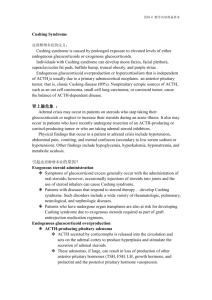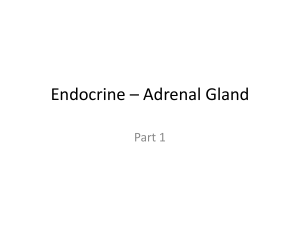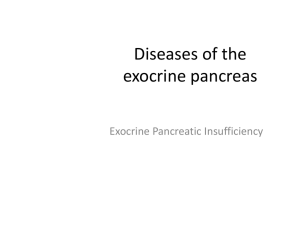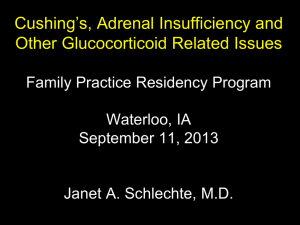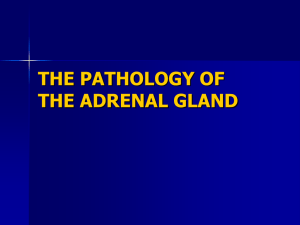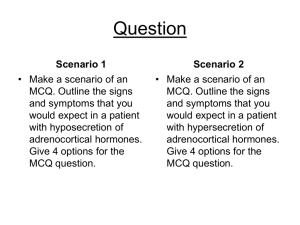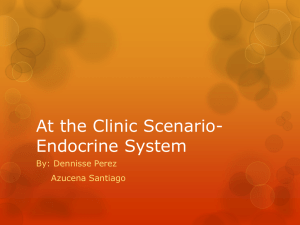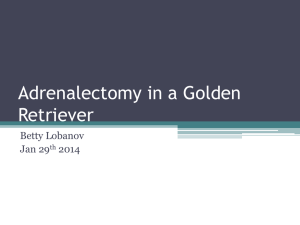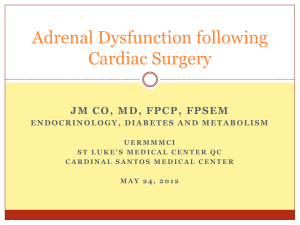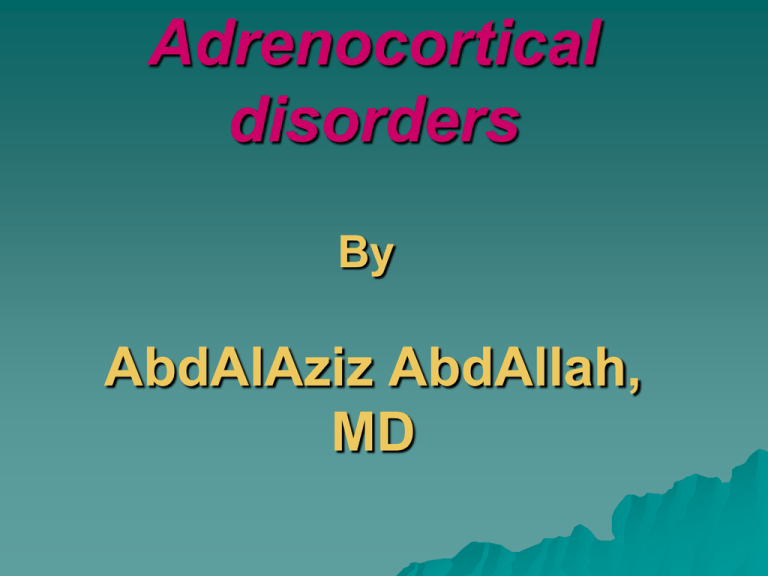
Adrenocortical
disorders
By
AbdAlAziz AbdAllah,
MD
The adrenal gland is divided into two
parts, adrenal cortex and medulla.
The adrenal cortex secretes androgen,
mineralocorticoids (eg, aldosteron) and
glucocorticoids (eg, crtisol).
The adrenal medulla secretes
catecholamines (eg, epinephrine,
norepinephrine, dopamine).
Aldosteron is primarily involved with
fluid and electrolyte balance.
Aldosteron secretion causes sodium
reabsorption in the distal renal
tubule in exchange for potassium
and hydrogen ions.
The net effects are, fluid retention,
decrease in plasma potassium and
metabolic alkalosis.
Aldosteron secretion is stimulated by;
-Renin-angiotensin system.
-ACTH.
-Hyperkalemia.
-Hypovolemia.
-Hypotension.
-congestive heart failure.
-Surgery.
Glucocorticoids are essential for life and have
mutiple pysiological effects.
Metabolic actions include enhanced
gluconeogenesis and inhibition of peripheral
glucose utilization.
Glucocorticoids are required for vascular and
bronchial smooth muscle to be responsive to
catecholamines.
Glucocorticoids are structurly related to
aldosteron, so they have aldosteron like action.
ACTH is the principal regulator of
Glucocorticoids secretion.
Secretion of ACTH and glucocorticoids
exhibit a diurnal rhythm, stimulated by
stress and inhibited by circulating
glucocorticoids.
Endogenous production of cortisol
averages 20 mg \ day.
Mineralocorticoid excess
I- 1ry hyper-aldosteronism (Conn
syndrome):
Conn syndrome is characterized by increased
aldosterone secretion from the adrenal glands, it
was first described in 1955 by J. W. Conn in a
patient who had an aldosterone-producing
adenoma.
Pathophysiology
Primary hyperaldosteronism is caused by
increased aldosterone excretion from the
adrenals, which results primarily from 2 major
subtypes:
(1) unilateral aldosterone-producing adenoma ,
Conn syndrome, (50-60% of cases)
(2) idiopathic hyperaldosteronism (IHA) or bilateral
adrenal hyperplasia (40-50% of cases).
(3) Rarely, aldosterone can be secreted by
adrenocortical carcinomas and ovarian tumors.
Aldosterone, by inducing renal
distal tubular reabsorption of
sodium, enhances secretion of
potassium and hydrogen ions,
causing hypernatremia,
hypokalemia, and metabolic
alkalosis.
Frequency:
Prevalence for Conn syndrome; 0.05-2% of the
population.
Mortality/Morbidity:
The morbidity and mortality associated with
Conn syndrome, are primarily related to;
1- Hypertension, especially if left untreated for
many years, can lead to many complications,
including heart disease (eg, coronary artery
disease, congestive heart failure), stroke, and
intracerebral hemorrhage (with very high blood
pressure).
2-Hypokalemia, especially if severe, causes
cardiac arrhythmias, which can be fatal
Age
Peak incidence occurs in the third to sixth
decades of life.
Sex
Primary hyperaldosteronism is twice as common
in women as in men.
II- 2ry hyperaldosteronism:
There is increased renin-angiotensin with
increased aldosteron secretion;
-CHF
-Liver cirrhosis and ascitis
-Nephrotic syndrome
-Renal artery stenosis
Clinical manifestations
-Hypertension;
-Hypokalemia;
patients with severe hypokalemia report fatigue,
muscle weakness, cramping, headaches, and
palpitations. They can also have polydipsia and
polyuria from hypokalemia-induced nephrogenic
diabetes insipidus.
-Metabolic alkalosis;
will lower ionized calcium levels and can
cause tetany.
Investigations:
Laboratory Studies
-hypernatremia
-Hypokalemia; normokalemia does not
exclude primary hyperaldosteronism. Several
studies have shown that 7-38% of patients
with primary hyperaldosteronism have
normal baseline serum levels of potassium
-metabolic alkalosis
-Renin levels are suppressed to less than 1
ng/mL/h in patients with primary
hyperaldosteronism.
-A 24-hour aldosterone excretion rate of
greater than 14 ug is diagnostic of primary
hyperaldosteronism
Imaging Studies
-CT scanning
-MRI
Treatment
Medical
medical therapy is used preoperatively to
prevent the morbidity and mortality associated
with hypertension and hypokalemia, thus
decreasing surgical risk.
- Sodium-restricted diet (<80 mEq or <2 g of
sodium per day.
-Potassium-sparing agent (first-step agent) such
as spironolactone100 mg initially, increase to
400 mg/d for control of blood pressure.
-Potassium supplementation should not be
routinely administered with spironolactone
because of the potential for the development of
hyperkalemia.
-Second-step agents include thiazides diuretics,
ACE inhibitors, calcium channel antagonists,
and angiotensin II blockers.
Surgical Care
Surgery is the main therapy for Conn
syndrome. A laparoscopic adrenalectomy
is favored, when possible
Anesthetic considerations
Preoperative correction of hypertension, CHF
and volume and electrolytes imbalance specially
potassium is mandatory.
Mineralocorticoid deficiency
-Hypo-aldosteronism
Atrophy or destruction of both adrenal
glands results in a combined deficiency of
Mineralocorticoid and glucocorticoid (
addison disease) .
-Isolated Mineralocorticoid deficiency;
-Unilateral adrenalectomy
-DM
-Heparine therapy
-congenital
C\P
*Hypotension; due to hypovolemia
*Metabolic acidosis
*Hyperkalemia; any increase in s.
potassium without renal impairment,
hypoaldosteronism should be considered.
*hyponatremia
Anesthetic management
Preoperative preparation includes;
*correction of fluid and electrolyte
imbalance
*exogenous mineralocorticoid,
fludrocortison 0.1-0.3 mg\ day.
Glucocorticoid excess
Cushing syndrome
Cushing syndrome is caused by prolonged
exposure to elevated levels of either
endogenous glucocorticoids or exogenous
glucocorticoids
Causes:
-Exogenous steroid administration
Symptoms of glucocorticoid excess generally
occur with the administration of oral steroids;
however, occasionally injections of steroids into
joints and the use of steroid inhalers can cause
Cushing syndrome.
Patients at risk to develop cushing syndrome
includes:
-rheumatological, pulmonary, neurological, and
nephrologic diseases that respond to steroid
therapy.
-Patients who have undergone organ transplants
due to exogenous steroids required as part of
graft antirejection medication regimens.
Endogenous glucocorticoid administration
-ACTH-producing pituitary adenoma (
Cushing disease).
-Primary adrenal lesions; Overproduction of
glucocorticoids may be due to an adrenal
adenoma, adrenal carcinoma, or
macronodular or micronodular adrenal
hyperplasia.
-Ectopic ACTH is sometimes secreted by oat
cell or small-cell lung tumors or by carcinoid
tumors
Frequency
Most cases of Cushing syndrome are due to
exogenous glucocorticoids. Endogenous
Cushing syndrome has been estimated at 13
cases per million individuals.
Age
The peak incidence of Cushing syndrome due to
either an adrenal or pituitary adenoma is in
persons aged 25-40 years
Ectopic ACTH production due to lung cancer
occurs later in life
Sex
The female-to-male incidence ratio is
approximately 5:1 for Cushing syndrome due to
an adrenal or pituitary tumor
Mortality/Morbidity
*Morbidity and mortality associated with Cushing
syndrome are related primarily to the effects of
excess glucocorticoids. However, a large
primary pituitary tumor may cause
panhypopituitarism and visual loss.
*adrenocortical carcinomas are associated with
a 5-year survival rate of 30% or less.
* multiple medical problems, including
hypertension, obesity, osteoporosis, fractures,
impaired immune function, impaired wound
healing, glucose intolerance, and psychosis.
* adrenal crisis
C\p
Obesity
-moon facies
-buffalo hump
-Central obesity, increased waist-to-hip ratio
greater than 1 in men and 0.8 in women
Skin
Facial plethora
abdominal striae
lanugo facial hair
Hirsutism and Steroid acne
Cardiovascular and renal
Hypertension and possibly edema may be
present due to cortisol activation of the
mineralocorticoid receptor leading to sodium and
water retention
Gastroenterologic
Peptic ulceration may occur with or without
symptoms.
endocrine
Galactorrhea and menstrual disturbances
decreased libido and impotence in men.
Skeletal/muscular
Proximal muscle weakness
Osteoporosis and osteopenia
Avascular necrosis of the hip
Neuropsychological
emotional liability, fatigue, and depression
Visual-field defects, often bitemporal, and
blurred vision
Adrenal crisis
Investigations
Laboratory Studies
Hyperglycemia
Hypokalemic metabolic alkalosis
Biochemical evaluation of Cushing syndrome:
1-Urinary free cortisol excretion over 150 ug\
day.
2- dexamethasone suppression test;
glucocorticoids inhibit secretion of hypothalamic
CRH and pituitary ACTH but do not directly
affect adrenal cortisol production. The overnight
1-mg dexamethasone suppression test requires
administration of 1 mg of dexamethasone at
11 PM with subsequent measurement of cortisol
level at 8 am.4 In healthy individuals, the serum
cortisol level should be less than 2-3 ug/dL.
3-loss of circadian rhythm of cortisol secretion
Normal values, 10-25 ug\ml in the morning, 2-10
ug\ml in the evening, elevated serum cortisol at
11 PM can be an early finding.
Recently, measuring salivary cortisol level has
gained interest, as it is a simple and convenient
way of obtaining a nighttime sampl. levels less
than 1.3-1.5 ng/mL exclude Cushing syndrome.
4- A plasma ACTH of less than 5 pg/mL is
suggestive of a primary adrenal tumor. An ACTH
level greater than 10-20 pg/mL is consistent with
ACTH-dependent Cushing syndrome.
Imaging studies
CT or MRI brain and abdomen
Treatment
*Hypopysectomy for pituitary tumors, or
adrenalectomy for adrenal tumors.
*Pituitary irradiation is employed when
transsphenoidal surgery is not successful or not
possible
*Patients with endogenous Cushing syndrome
who undergo resection of pituitary, adrenal, or
ectopic tumors should receive stress doses of
glucocorticoid in the intraoperative and
immediate postoperative period
*lifelong glucocorticoid and mineralocorticoid
replacement is necessary in those patients who
undergo bilateral adrenalectomy.
Anesthetic considerations
Preoperative management
From the C\P those pt. Tend to be volume
overloaded, hypertensive and hypokalemic, so
Preoperative correction of these factors are
essential by potassium and spironolactone.
Intaoperative
Patients with osteoprosis are at risk for fracture
during positioning.
Preoperative weakness may indicate an
increased sensitivity to muscle relaxants.
Supplemental steroids are indicated for;
-patients with Cushing syndrome due to
exogenous glucocorticoids
-patients undergoing adrenalectomy
Dose; I.V. hydrocortisone succinate 100 mg
every 8 h beginning the evening before surgery
or on the morning of surgery.
Other complications of adrenalectomy include
significant blood loss and unintentional
pneumothorax.
Pseudo-Cushing Syndrome
In 1976, Smalls and associates described 3
alcoholic patients who had the physical and
biochemical abnormalities of Cushing syndrome.
Most of the abnormalities disappeared with 1-3
weeks of alcohol abstinence. About 30 cases
have been reported.
Pathophysiology
The mechanism remains unclear. Most evidence
suggests central stimulation of a corticotropinreleasing hormone, either at the hypothalamic or
suprahypothalamic level.
Persistence of abnormalities may lead to
complications such as hypertension, glucose
intolerance, diabetes mellitus, and osteoporosis.
The most important part of the history is the
extent and duration of alcohol abuse.
Glucocorticoid deficiency
Addison Disease
Thomas Addison first described the clinical
presentation of primary adrenocortical
insufficiency (Addison disease) in 1855 in his
classic paper, On the Constitutional and Local
Effects of Disease of the Supra-Renal Capsules.
Pathophysiology
Addison disease is adrenocortical insufficiency due
to the destruction or dysfunction of the entire
adrenal cortex. It affects glucocorticoid and
mineralocorticoid function. The onset of disease
usually occurs when 90% or more of both
adrenal cortices are dysfunctional or destroyed.
Frequency
The prevalence of Addison disease is 40-60 cases
per 1 million population.
Causes
1- idiopathic autoimmune adrenocortical
insufficiency.
2- Chronic granulomatous diseases; TB,
sarcoidosis, histoplasmosis.
3- Hematologic malignancies; as Hodgkin
and non-Hodgkin lymphoma and leukemia.
4- Metastatic malignant disease; as metastatic
cancer of the lung, breast, colon or renal cell
carcinoma.
5-Infiltrative metabolic disorders; Amyloidosis
and hemochromatosis.
6- AIDS.
Age
The most common age at presentation in adults
is 30-50 years.
Sex
Idiopathic autoimmune Addison disease tends to
be more common in females and children.
Secondary adrenal insufficiency is a result
of inadequate ACTH secretion by the
pituitary, the most common cause of
secondary adrenal insufficiency is
iatrogenic, the result of the administration
of exogenous glucocorticoids.
C\P
Patients usually present with features of both
glucocorticoid and mineralocorticoid deficiency.
The predominant symptoms vary depending on
the duration of disease.
-Hyperpigmentation of the skin and mucous
membranes due to high ACTH.
- vitiligo, which most often is seen in idiopathic
autoimmune Addison disease.
-clinical manifestations due to aldosteron
deficiency; hyponatremia, hypovolemia,
hypotension, hyperkalemia and metabolic
acidosis
-clinical manifestations due to cortisol deficiency;
weakness, fatigue, hypoglycemia, hypotension,
and weight loss.
-Prominent gastrointestinal symptoms may
include nausea, vomiting, and occasional
diarrhea.
- Patients with secondary adrenal
insufficiency have a history of tacking cortisol.
- acute adrenal crisis
Investigations
Laboratory Studies
-ACTH stimulation test; In patients with Addison
disease, both cortisol and aldosterone show
minimal or no change in response to ACTH.
-hyponatremia
Hyperkalemia
metabolic acidosis
-elevated (BUN) and creatinine due to the
hypovolemia with decreased glomerular
filtration rate.
-Hypoglycemia
-adrenal autoantibodies may be present
Imaging study
Chest x-ray TB
CT abdomen
Treatment
The goals of pharmacotherapy are to reduce
morbidity and to prevent complications e.g
adrenal crisis;
1- corticosteroid: Prednisone 5-7.5 mg PO qd in
am or 5 mg PO qd in am and 2.5 mg PO qd at 45 pm.
2- mineralocorticoid: Fludrocortisone 0.05-0.1
mg PO qd; some patients may only require
alternate-day dosing.
Anesthetic considerations
Preoperative management
*ensure adequate replacement therapy
*correct fluid and electrolytes disturbaces
*for all patients who have received potentially
suppressive doses of steroids, the daily
equivalent of 5 mg of prednisone, by any route
of administration- topical, inhalational or oral-,
for a period of more than 2 weeks any time in
the previous 12 months may be unable to
respond appropriately to surgical stress.
Adults normally secrete 20mg of cortisol daily,
this may increase to over 300 mg under maximal
stress.
- 100 mg of hydrocortisone phosphate every 8 h
beginning the evening before or on the morning
of surgery.
-an alternative low dose regimen, 25 mg of
hydrocortisone phosphate at the time of
induction followed by an infusion of 100 mg
during the subsequent 24 h, and this might be
appropriate for diabetic pt.
Intaoperative
ensure adequate fluid.
Postoperative
Continue the stress dose of steroids to gard
against acute adrenal crisis.
11- beta Hydroxylase Deficiency
Congenital adrenal hyperplasia (CAH) is a
general term used to describe a group of
inherited disorders in which a defect in cortisol
biosynthesis is present with consequent
overproduction of (ACTH) and secondary
adrenal hyperplasia as a consequence.
Causes
An autosomal recessive disease.
Patients with 11-beta-hydroxylase deficiency
present with features of androgen excess,
including masculinization of female newborns
and precocious puberty in male children.
Approximately two thirds of patients also have
hypertension, which may or may not be
associated with mineralocorticoid excess,
hypokalemia, hypernatremia and metabolic
alkalosis.
The hypertension is initially responsive to
glucocorticoid replacement, but it may become a
chronic condition subsequently requiring
standard antihypertensive therapy.
Addison Disease and Pregnancy
-Before glucocorticoid replacement therapy
became available, pregnancy in patients with
adrenal insufficiency was associated with a
maternal mortality rate of 35-45%.
-The usual glucocorticoid and mineralocorticoid
replacement dosages are continued throughout
pregnancy. Some patients may require slightly
more glucocorticoid in the third trimester.
During labor, adequate saline hydration and 25
mg of intravenous cortisol (ie, hydrocortisone
sodium succinate) should be administered every
6 hours.
At the time of delivery or if the labor is
prolonged, high-dose parenteral hydrocortisone
should be administered (100 mg q6h or as a
continuous infusion).
After delivery, the dosage can be quickly tapered
to a maintenance dose in 3 days.
Cushing Syndrome and Pregnancy
The risk of maternal morbidity and a poor fetal
outcome is significant when Cushing syndrome
coexists with pregnancy.
Maternal hypertension may antedate the
pregnancy but becomes worse in two thirds of
patients.
Preeclampsia or pregnancy-induced
hypertension is noted in approximately 10% of
patients.
Gestational DM occurs in approximately one third.
Congestive heart failure associated with severe
hypertension occurs in 10%.
Wound breakdown after surgery is possible.
Severe proximal myopathy and mental problems
ranging from emotional lability to profound
psychosis should be added to the list of medical
problems that may occur.
Primary Hyperaldosteronism and Pregnancy
Patients present with hypertension,
hypokalemia, and elevated urine potassium
levels.
The goals of medical therapy should be
adequate control of blood pressure and
replacement of potassium
spironolactone and angiotensin-converting
enzyme inhibitors, are contraindicated in
patients who are pregnant.
Methyldopa, beta-blockers, and calcium channel
blockers have been used with variable outcomes


